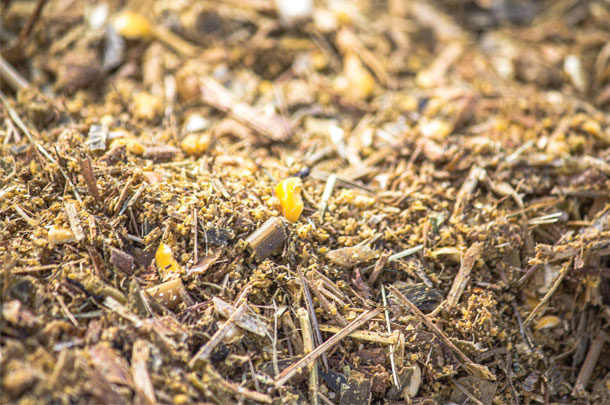We have learned a lot in the last 4,000 years of silage making, especially during the last decade when a quantum leap in the understanding of fermentation science occurred. Still, the fundamentals of fermentation have never changed.
Making high-quality fermented forages for your animals is all about getting the fundamentals right. Abiding by this adage, “When you think you’re doing it right, you’re overestimating yourself,” is a good way to keep improving your forage quality and profitability – and avoid becoming complacent.
Here are four fundamentals of producing high-quality silage.
1. Harvest corn with optimum moisture content
When chopping corn silage, the plant should be 32% to 38% dry matter. Ensiling feed that is too dry will cause packing problems. Ensiling feed that is too wet will result in poor fermentation, seepage and possible production of undesirable butyric or acetic acid.
Test the dry matter of the whole corn plant to determine when to harvest your crop. This microwave method for testing moisture content is quick, easy and accurate in the absence of a moisture tester. Do not use a household microwave. You can usually pick a cheap microwave up at the local thrift store.
Microwave method
Weigh out 100 grams of silage (adjusting for the weight of the dish) and spread it evenly on a plate in a microwave oven. Heat on high for about four minutes (depending on the strength and age of your oven). Remove the silage, weigh and record. Heat the sample again on high for 1 minute, then weigh and record. Repeat this procedure until the weight remains the same. At this point, the weight in grams represents the dry matter (DM) content of the silage. To calculate the moisture content, subtract the DM content from 100. For a sample that weighs 34 grams, the DM is 34% and the moisture is 66%.
2. Pay attention to kernel processing
In corn, the kernel is the most nutritious part of the plant. It contains the majority of the starch and energy. When feeding corn silage to cattle, the kernel must be processed, or a majority of the nutrients will pass through the cow and wind up in the manure.
Your goal is to obliterate all of the corn kernels during harvesting so that no whole kernels end up in the silo. Theoretically, kernel processing is very simple, but it is much more complicated to manage on the farm.
It can be expensive to properly maintain kernel processing rolls, and complete kernel processing takes more time and uses more fuel. If you are using a custom harvester, you need to keep an eye on the quality of the material going to the feedbunk. If the custom harvester is running multiple choppers, pay attention to the feed coming from all of the machines. Sometimes a spot check can be misleading because one harvester is working fine, and another may need to be dialed in. Grab a 32-ounce plastic cupful from each harvester. Spread the sample out on a flat surface and go through the kernels. Count all the kernels that are half of a kernel or more. A goal is to have less than two of the half-to-whole-sized kernels per 32-ounce sample.
3. Be fanatical about oxygen management
Oxygen is the natural enemy of quality silage. By placing the crop material in a silo and sealing it, the feed is preserved, similar to a compost heap. The major difference between a compost heap and a silo is that air moves freely in a compost heap but not in a silo.
To eliminate oxygen from the silo, you must pack it completely and cover the silo as quickly as possible. There is a direct correlation between silo packing density and dry matter loss. It’s very difficult to see a diminishing return on packing too much. Prior to harvest, determine how many tons of forage you will be bringing to the silo per hour and make sure you have enough packing capacity (per hour) for that amount of tonnage. Pack the silo to a density of 16 feet per meter by using a heavy packing tractor with narrow tires to maximize pounds per square inch.
Spread the freshly delivered forage in thin layers as you pack. Dumping a big load in one spot and trying to pack it down is less effective than spreading out 6-inch layers. The packing tractor should work 30 to 45 minutes after the last load goes to the bunk.
Do everything you can to research proper packing techniques and get a detailed plan together prior to harvest. Brian Holmes and Richard Muck (University of Wisconsin) developed a bunker silo silage density calculator (available online) to help producers design silos.
Another element of oxygen elimination is getting the silo covered and sealed as quickly as possible. As the silage starts to heat up from fermentation, the hot air rises and pulls in fresh oxygen. Fresh oxygen will further degrade the feed and cause additional heating. Covering the silo keeps the warm air from escaping and shuts off airflow in the silo.
4. Don’t forget feedout
Much of the dry matter losses on silage occur at feedout. The exposed silage face will start to degrade when exposed to oxygen. Keeping the face of the silage pile as small and smooth as possible reduces oxygen exposure and helps maintain the nutritional integrity of the feed. Don’t dig deep into the face of the silage pile and cause fractures for oxygen to invade. Carefully use the loader to pull down only as much forage as you will feed right away.
Feeding and pushing feed more often will keep your silage fresher and more palatable to the cows. Be diligent about silage being fed out in the summertime. You may want to consider using a bacterial silage inoculant containing Lactobacillus buchneri to help keep the feed cooler and extend its shelf life after being exposed to oxygen. Lactobacillus buchneri is not the appropriate bacteria for all situations, so consult your nutritionist for help in choosing proper inoculants for each situation.
Conclusion
Silage is your most controllable feed cost and the most important to the overall health of your herd. It is much easier to tell producers how it should be done than to actually implement and execute it properly. Weather, equipment failure and other unpredictable forces can wreak havoc on the best-laid plans. Having a detailed plan and a plan B are critical for when those inevitable real-life events occur.
And remember, “When you think you’re doing it right, you’re overestimating yourself.” ![]()
PHOTO: The goal is to obliterate all corn kernels during harvesting so that no whole kernels end up in the silo. Photo by Lynn Jaynes.
References omitted but are available upon request. Click here to email an editor.

-
Jim Mattox
- CEO
- Cowsultants
- Email Jim Mattox











